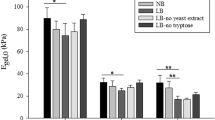Abstract
For biofilm studies, artificial models can be very helpful in studying processes in hydrogels of defined composition and structure. Two different types of artificial biofilm models were developed. Homogeneous agarose beads (50–500 μm diameter) and porous beads (260 μm mean diameter) containing pores with diameters from 10 to 80 μm (28 μm on average) allowed the embedding of cells, particles and typical biofilm matrix components such as proteins and polysaccharides. The characterisation of the matrix structures and of the distribution of microorganisms was performed by confocal laser scanning microscopy. The physiological condition of the embedded bacteria was examined by redox activity (CTC-assay) and membrane integrity (Molecular Probes LIVE/DEAD-Kit). Approximately 35% of the immobilised cells (Pseudomonas aeruginosa SG81) were damaged due to the elevated temperature required for the embedding process. It was shown that the surviving cells were able to multiply when provided with nutrients. In the case of homogeneous agarose beads, cell growth only occurred near the bead surface, while substrate limitation prevented growth of more deeply embedded cells. In the porous hydrogel, cell division was observed across the entire matrix due to better mass transport. It could be shown that embedding in the artificial gel matrix provided protection of immobilized cells against toxic substances such as sodium hypochlorite (0.5 mg/l, 30 min) in comparison to suspended cells, as observed in other immobilized systems. Thus, the model is suited to simulate important biofilm matrix properties.
Similar content being viewed by others
Author information
Authors and Affiliations
Additional information
Received: 21 December 1999 / Received revision: 7 March 2000 / Accepted: 10 March 2000
Rights and permissions
About this article
Cite this article
Strathmann, M., Griebe, T. & Flemming, HC. Artificial biofilm model – a useful tool for biofilm research. Appl Microbiol Biotechnol 54, 231–237 (2000). https://doi.org/10.1007/s002530000370
Issue Date:
DOI: https://doi.org/10.1007/s002530000370




